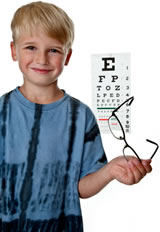
 Have you had your Child's Eyesight Tested?
Have you had your Child's Eyesight Tested?Some learning difficulties could simply need a quick eye test
A valued member of our team share's their experience…
My daughter has never had learning issues as such and does very well in school (now in Year 2), however I had noticed in pre-school and Kindergarten that she was very fidgety and lacking in focus when it came to doing her home readers.
Sound familiar? This of course could be down to personality, tiredness or the subject matter of the book (let's face it, most those home readers are deadly boring at the best of times). However, in my daughter's Kindergarten year her class did a trip to the local hospital where they have a Visual Sciences Unit. They all learned about how the eye works and had a basic eye test.
My daughter's report said they recommended a full eye test as she had some suspected issues with focusing and eye coordination. I put this to the back of my mind thinking that they probably said that to everyone until my conscience got the better of me. So when I went for my next eye appointment, I booked in my daughter too.
As it turns out, her actual vision was great, but she had a problem with Convergence, i.e. her eyes didn't turn in adequately and in sync in order to focus on near sight activities, such as reading. One had a tendency to drift out which meant her focus was off and she was actually missing words entirely and it can also give double vision or overlapping vision. This was determined by a very simple test and also easily corrected with simple exercises. But it's essential that it's diagnosed and treated as early as possible. In my daughter's case, literally a few weeks of those exercises made a huge difference.
Specsavers is urging parents to watch their kids for signs of poor eyesight once they're back at school. Some common eye problems that can occur amongst young children include long or short sightedness, astigmatism, which results in distorted vision, colour deficiencies and lazy eye.
According to Specsavers' Optometrist and Managing Director, Peter Larsen, more than 60% of children who are 'problem learners' have been found to suffer from undetected vision problems1.
"Almost two thirds of children who struggle with learning have undiagnosed vision problems, meaning the solution could be a simple as a pair of glasses," he said.
"Around 80% of everything a child learns is through their vision, so good eyesight is one of the most important tools for their learning and development.
"Misdiagnosis means the underlying vision problem is not addressed and the child may continue to struggle with learning and fall behind their peers. This could result in the child being labelled incorrectly as having a learning difficulty, which could have a major impact on their confidence and their perception about what they're capable of achieving throughout their lives".
Mr Larsen said undetected vision problems were estimated to affect approximately one in four Australian children[1], while around one in six Australian children wear glasses or contact lenses to correct their sight[2].
"Even basic issues with their sight can have a profound impact on children but some conditions require swift intervention", he said.
"For example, if a child has a squint, it can be treated relatively easily if caught early on but after the age of seven or eight, the likelihood of needing surgery increases dramatically.
"It is extremely important that a child's eyesight is checked regularly. After eight is often too late because after this age it is much harder to correct any vision problems which may have developed".
There are a number of tell-tale signs that a child may experience vision difficulties. Some signs to look out for include:
- Reading problems – Children who frequently skip lines or lose their place while reading books may have vision problems.
- Squinting – If a student is frequently squinting at the blackboard, they may be trying to compensate for their poor vision.
- Sitting too close to the television – Short-sighted children generally have clear vision at a close range and poor vision at a distance.
- Rubbing eyes and headaches – If your child rubs their eyes excessively or complains of headaches regularly, it may mean their eye muscles are fatigued from straining.
- Clumsiness - Children might have trouble realising how close or far away objects really are. Sometimes young children who do not walk well actually have problems with their vision.
- Behaviour - Some children who have vision problems appear to have a short attention span and may misbehave due to frustration.
 Specsavers recommends children should have their eyes tested at least every two years from the age of three, and is urging parents to book an eye test to ensure nothing is impeding their child's vision and consequently their ability to learn.
Specsavers recommends children should have their eyes tested at least every two years from the age of three, and is urging parents to book an eye test to ensure nothing is impeding their child's vision and consequently their ability to learn.| Specsavers is kindly offering two amazing prize vouchers comprising of custom fit designer frames and an eye test at Specsavers. The value of each voucher is approximately $800. To go into the draw* complete our Annual Child Care & Workforce Participation survey and have your say here. *Terms & Conditions |
© 2012 - All rights reserved
Care For Kids Internet Services Pty Ltd
ABN 55 104 145 735
PO Box 543 Balmain NSW 2041
privacy policy contact us